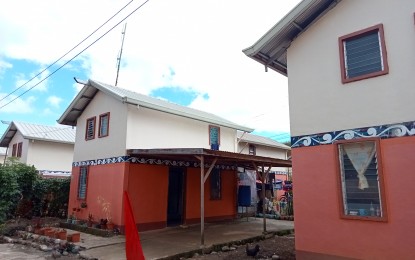
NEW HOUSES. The United Nations Human Settlements Programme will end its Rebuilding Marawi Project in Marawi City on May 30, 2022 with 1,000 permanent houses for families displaced during the five-month siege in 2017. The agency known as UN-Habitat received funding from the Japanese government. (PNA photo by Divina M. Suson)
MARAWI CITY – For a 38-year-old mother of nine, life five years after the siege here is way better than before they were displaced because of the five-month battle between the government and ISIS-linked extremists.
Anisah Bariga, her husband, and their children aged between 17 to 5 months old occupy one of the 109 permanent housing units in Hadiya Village in Barangay Dulay West.
They transferred here in February last year, a shelter she calls "our own", vacating the house of a kind relative some four kilometers away from Dulay West.
When they fled during the siege, they first stayed for six months in a school that served as evacuation center in Saguiaran, Lanao del Sur.
"It was very difficult living in an evacuation center with six little children so right after the (declaration) of Marawi liberation, we asked our relative if we can stay in their house. They let us stay there while waiting for the opportunity to be given permanent housing," Bariga said.
The United Nations Human Settlements Programme (UN-Habitat) constructed 1,000 permanent shelters for displaced families who could no longer go back to their areas in the most affected area (MAA).
The agency spent some USD10 million donated by the Japan government for the Rebuilding Marawi Project.
Bariga said she has accepted the fact that they could no longer go back to their previous area inside the MAA.
She understands that the MAA has been declared a no-build and danger zone because it is within the reclamation area and the easement of Lake Lanao along the river banks.
Comfortable life
At Hadiya Village, Barriga’s family is comfortably living in a house with a 42 square meter floor area, sitting on a 100 square meter lot.
The couple makes a living out of selling dodol, a Maranaw delicacy made of sticky rice flour, coconut milk, and sugar.
A family friend allowed them to construct a small bamboo shade along the road in Barangay Lilod Saduc to sell their wares and where commuters regularly pass by.
"Our house before [the siege] was small," Bariga said. "And now we have a better income because we were able to find a good spot, unlike before that we were inside the Padian market."
Worries, uncertainties
While Bariga’s family is content with their life now, Taib Gauraki, who was also given a permanent shelter in the same area, is worried about the ownership of the land.
He learned that the government paid only 25 percent for the total land area of 2.8 hectares.
"They said this is a permanent shelter, but how long should we wait before these lots will be paid for (by the sponsoring agencies) and guarantee we will not be evicted?" Gauraki said.
Engineer Felmar Gilbang, project manager of the Social Housing Finance Corporation (SHFC), said relocated residents are assured they will not be evicted.
The heirs of the original land owner, who is already dead, issued a conditional deed of sale to the SHFC for the title transfer after receiving the 20 percent of the price of the property.
“May certificate of award naman na ibinigay sa mga (A certificate of award was given to the) homeowners,” Gilbang said in an interview.
Marawi Mayor Majul Gandamra said that 1,000 of more than 3,000 families who lived in the different transitory shelters have transferred to permanent units in five areas -- Hadiya Village in Barangay Dulay West, Norsalam Village in Barangay Patani, Pamayandeg Ranaw Residence in Barangays Kilala and Mipantao-Gadongan; and Darussalam Village in Barangay Dulay Proper.
The SHFC and the National Housing Authority purchased the land in the five areas.
Some of the remaining families are waiting for compensation under the Marawi Compensation Law so they can rebuild their houses.
“Many of them already have approved building permits and there are many others still waiting,” Gandamra said.
Praying for compensation
Abduljalil Madid, homeowners’ association president of Hadiya Village, said they are banking on the promises of the compensation law.
"Hopefully, the next administration will continue to support us like what President Rodrigo Duterte did for us. I hope they will give solution to the other problems that were not yet addressed," he said, referring to livelihood programs and amenities inside the housing site such as a public market.
On May 30, the UN-Habitat will wrap up its Marawi Resettlement Site projects.
Aside from core shelter project, the UN-Habitat also engaged in the livelihood skills training, community development, peace structures, mapping, and community infrastructures.
As of this month, 923 houses have completed construction and 77 will be finished by June.
Of the 923, a total of 538 were already turned over.
“The planning of the construction of these houses were participated in by the beneficiaries so that the house designs are culturally-sensitive,” Christopher Rollo, country program manager of UN-Habitat Philippines, said in an interview.
“The Rebuilding Marawi Project demonstrates that adequate housing is at the center of sustainable development because having an adequate home empowers a family to satisfy its basic needs while providing the space to dream, engage in gainful livelihood, commune with neighbors, and become communities of peace,” Rollo added. (PNA)
